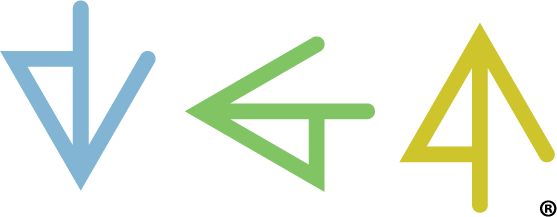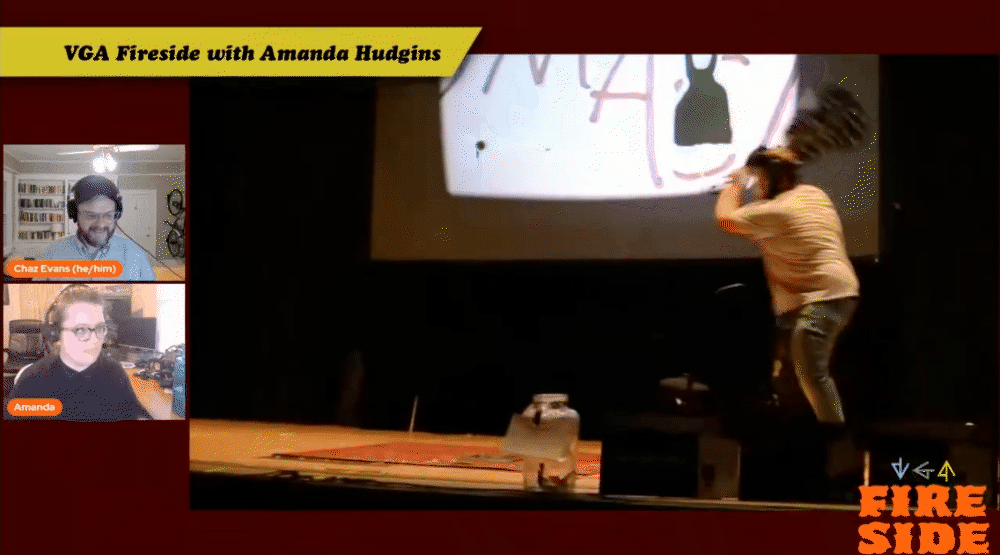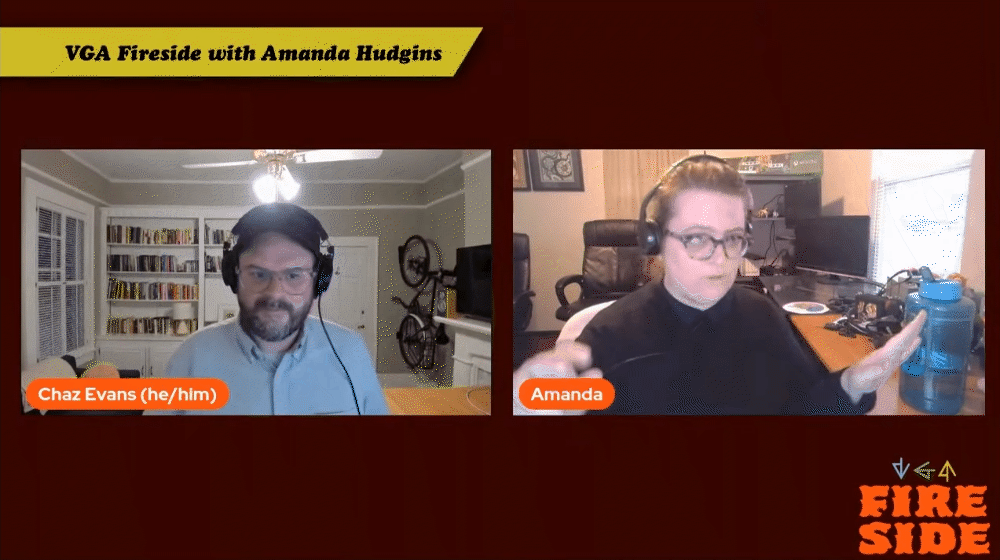VGA Fireside Ep. 12 feat. Amanda Hudgins: Interview Highlights
VGA Gallery welcomes Amanda Hudgins (@BarelyConcealed) to a new episode of VGA FIRESIDE! Hudgins is a writer and game designer based out of Lexington, KY. Their work, which has been shown internationally, pushes the boundaries of what a video game controller can consist of. They are a columnist for the digital magazine Unwinnable.
Below are some of the highlights from Chaz Evans’ conversation with Amanda, edited for clarity and brevity. The full interview can be found on VGA Gallery’s YouTube and Twitch channels, where you can see footage from their projects, The Claw, One Night Only, and more!
On how Amanda got started in the gaming field
Amanda Hudgins: I actually graduated from the University of Kentucky with a degree in English literature. So, not really in game making at all, not at least the way that people traditionally think of that. Then I started dating my now husband. Around the time I started dating him, he used to run these things, on his own, called Creative Jams. It's basically a game jam, but some people quilted, and some people made sweaters, and I think I wrote a children's book for one of his early creative jams. And he was like, “Oh, if you like this, then you'll definitely like this game jam that's coming up!”
It was Global Game Jam, I think 2011 or 2012, whatever the year was that the “heartbeat” was a theme. And I was like, “Oh, this is fun!” So I made a bunch of HTML web pages that connected. After which someone was like, “oh, so did you use Twine?” And no, I did not use Twine. I used to use HTML pages—also works!
So that opened it up for a lot of things. I actually went back and got a second degree, again, in media arts and studies. A telecommunications degree is what it used to be called. And basically what I like to tell people is that it covers everything from how an AM radio tower works to how to build a website. It's a very broad degree. So I got two degrees from the University of Kentucky. And then for that degree, I had to get an internship. So I talked to one of the three local studios in Lexington, and I have been working for Super Soul ever since.
On alternative game controllers
AH: My background is very non-traditional. So, I like to say that that helps me ignore a lot of the constraints because I don't know why they're there. Like, I don't know enough about what I'm doing to not know why I can't do it.
So I got into alternative controls, actually, because Super Soul made a game that was featured at alt.ctrl.GDC. It was made by one of my previous employers, Richie Hoagland, mostly, but also Super Soul at large. It was called Deluxe Turbo Racing 360: If you've ever had a Xbox 360 controller on your table, it starts vibrating. The design of that was that he made the motors equal, so you could race them across a table. It became a physical sort of racing game using the controllers as actual things.
It was a really good idea. It was at, I think, the inaugural alt.ctrl.GDC because that's where I also saw Robin Baumgarten's piece, Line Wobbler. And a couple of other things. I think that's where I met Jerry Belich. He's another sort of prominent designer, and just saw a lot of different pieces from all over the world. And that was what really got me thinking, Oh, this would be a fun thing to do.
On how The Claw exhibition came to be
AH: So The Claw is an exhibition of eight art claw machines. Basically, the idea was we purchased a bunch of claw machines from a place in Pittsburgh. And we had a bunch of different local artists add their own spin on the individual claw machines. So, the idea was to take something that was a consumer grade product that you would see at like a Steak and Shake (most of these came from Steak and Shakes) and reimagine it. We were kind of basing it off of the idea of a lot of cities having those big fiberglass objects that were painted individually. In Lexington they're horses, because Kentucky and horses.
We were thinking, if we gave everyone a standardized object, what would they come up with? And so the options are, say this one, which is just by one of my Super Soul fellow employees, Shea Rembold. And it's sort of a digital claw machine where you pick up figures, and then it has a little window on the front, where they trap them. And you're a giant terrifying claw from the sky kidnapping cute animals and dropping them into a hole.
There's everything from that to a Zen machine, where it's a rock garden where you drag a rake through rocks. And it kind of really felt like a challenge to what you think of when you see a claw machine, which is, you know, the idea of grabbing something and taking it. It was more about creating this really tranquil space where you play and move. But in, you know, a very sedated manner.
Chaz Evans: When I saw this documentation for the first time, the rock garden quickly became a visual favorite, just because it so quickly takes the claw machine and puts it in a different direction. It's the claw machine that doesn't take.
AH: There is no collection at all happening from that machine! It was also just to be totally frank, very fun to design visually. Basically, none of these machines are running their original code—they have their original code like all the stuff is still in there, you could plug them in, and they theoretically still work as claw machines.
On their alternative control scheme for the One Night Only exhibition
AH: One Night Only was actually inspired by a GDC party that I never went to, and also didn't happen… I saw a post from Nathalie Lawhead talking about it. The idea was that people made games for this event, then at the end of the event the game is destroyed. And so I was like, “Oh, that'd be great except, you know, you deleted the code, but the computers are still there?” Like, I'm an alt-control designer, right? If I can destroy things, I destroy them!
I texted Bit Bash. And I said, joking (I was actually at a bar) “Hey, how much could you budget for me to smash guitars on stage at Bit Bash this year?” And they wrote back and said, “Oh, how much are you thinkin’?” Enthusiastic support 100% of the way, which meant I had to now figure out how much money was doable.
I believe it was 16 guitars. And a controller that sometimes worked. That's mostly on me. We had to go through a lot of gloves, and vague protection measures. And the idea was it was kind of a rock band-ish game… This was also a thing I worked on with my partner, Matthew Hudgins. We smashed guitars on stage and it went super well. People had a lot of fun, I think! It was exactly One Night Only.
CE: So you get a batch of guitars and you customize them to play this homebrew rhythm game that's Guitar Hero-esque. And then at what point does the participant decide to smash, is it up to them?
AH: The idea is you're fighting this figure. In this case, that's the guy with the safety cone. So you're fighting him, it's a boss fight, you play the rhythm game, and at the very end, it will tell you on screen: SMASH. And there is a metal plate on the floor. So, it registers when you smash, because there's copper tape all along the thing you smash, and then when you do that, it sets him on fire… I wanted you to feel like a rock star. And to feel like a rock star is to stand on the middle of a stage and absolutely demolish your guitar, which is something that you'll never get to do, right? Most of us will never be in a position where we can destroy a guitar, which might have been $30 a piece. But you never get to experience that, and so for me alt-control is sensation and experience.
On how alternative controllers are changing the gaming space
CE: It's safe to say that working with alternative controls isn't just about having a unique experience, which it already does provide, but it also starts to question assumptions made by standardized controllers about our expectations?
AH: Yeah, and what is the expectation for play. But also what is the expectation for the player? One of my favorite alternative control experiences is one my partner made for a game he was working on that I don't think he ever technically released. It's called Spacetraff. And in Spacetraff, he wanted to make it so that anyone could play. If you hand someone a controller, like a traditional controller, they can get really uncomfortable, especially if they're not from that space, which is something I think a lot of game designers take for granted. If I hand you an Xbox controller, and you've never touched one before, they're really intimidating.
What he did was he made a bunch of foot pedals, because it's a one button game. And people would be like, “Oh, I don't play games.” and he'd be like, “You can drive a car!” And pulled them over and then they would be able to play. I think that's for me, what's exciting, to me personally about alternative controls is that there are real democratization of what is happening in games. If I handed you a controller or a keyboard and mouse, if you were able to just engage with that on different terms, so that everyone is also confused, that also works.
Centenntable button table. Image courtesy of Amanda Hudgins.
How Amanda's experience in several different industries has affected their work
AH: A lot of my design comes from a standpoint of narrative design, because that is my principal training and also my longest creative background. I was the kid with all those 70-page notebooks that were filled with stories that are now lost to time. So I was always going to be a narrative designer, probably, or in writing in general.
The first game I ever showed an event, I showed at PAX, and it was a was a really alarming first event. I'd never been to a game event before, and the first one I went to was PAX East. The first game I showed was a narrative game about I think, a zombie apocalypse in Kentucky, and you murder someone with a frying pan. All roads lead to you murdering someone with a frying pan. It makes sense, I promise, probably. That's the first game I ever showed, was a twine game about murdering someone with a frying pan at PAX. And so I got really used to people hating what I made. It's the nicest way to put that.
So the very first time I showed Centenntable, actually, I think Bit Bash is another good example of this, which is Centenntable was my first thing that I showed other places. That was an alternative controller, I'd had previous projects, but that's the first one that I showed at places outside of Kentucky, and I remember thinking I was blown away because it was again, Bit Bash. I was like, Oh, hey, I just wanted to know if I can submit something. And I think it was Brice that wrote me back immediately and said, "if it's that thing with all the buttons, I want it."
On how alternative controller design has inspired their passion for artistic event planning
AH: For me, the most important thing that I got out of any of this stuff is I really love event planning. Specifically for art events, because I think it's a really great way to get people into the door who otherwise would not engage with this type of media at all. That, for me, is the most exciting thing. Showing off to other developers is fine; showing off to other gamers is honestly worse; but showing off to people who are coming out on Friday night to go see a bunch of paintings and galleries, and then they come across your thing, and you see like the glee they get when a 65 year old man gets a plushie for the first time from a claw machine…
On how regional location is relevant to Amanda’s journey becoming an alt-control designer
AH: I think I wouldn't be making this kind of thing if I lived in a major city both because I don't think I'd be able to afford the space to do it and also, just from like a practical standpoint, and also because Kentucky is weirdly like the alt control was for a while we joke that we were the alt can control capital of this country, because there's just so many people here who were all making things, and you could drive to RadioShack and buy the parts, which you can't do anymore, because RadioShack is dead, but like you get the parts for it. And you had a community of people who were all doing this and I wouldn't have done this necessarily. If Richie Hoagland hadn't made Deluxe Turbo Racing 360, I never would have gone to it. Like, right now my community for alt control is incredibly multinational, but it wouldn't have ever started without that local connection first.
A little bit about Amanda’s current ongoing project, The Dementia Quilt
AH: I have a project I've been working on for two years that I've been referring to as The Dementia Quilt, because I'm bad at naming. I have a local developer friend named Miles Mojo, who has helped me name things because I'm bad at naming them. But the idea is, I wanted to create a touch-based quilt that talks about memory and memory loss in relation to my grandmother, because she both taught me how to quilt and also passed away from dementia and COVID. I wanted to combine all those things together into a project… The idea is to use conductive thread, and then the conductive thread is embroidered into the quilt and then you can touch it and stroke it and it is going to use audio cues to talk to you and tell you stories and memories. And then those memories can be fragmented as can the embroidery on the quilt.






